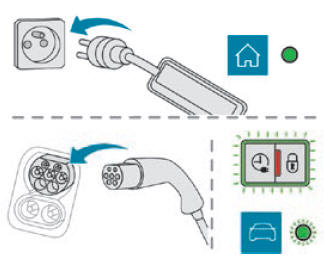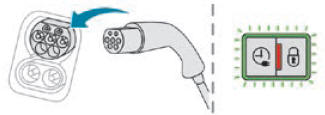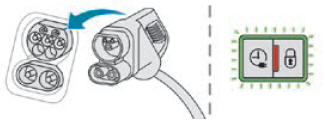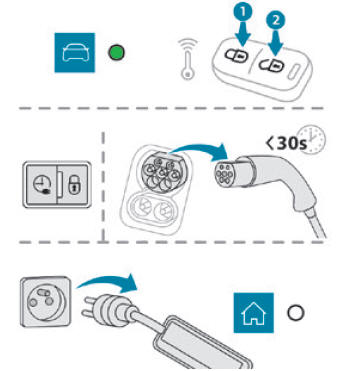To recharge, connect the vehicle to a domestic electrical system (for domestic or accelerated charging) or a fast public charging station (for fast charging).
For a full charge, follow the desired charging procedure without pausing it, until it ends automatically. Charging may be performed either immediately or deferred.
You can stop charging at any time by unlocking the vehicle and removing the nozzle.
For more information on the charging displays on the Přístrojový panel a Dotyková obrazovka, viz odpovídající část.
Depending on version, the deferred charge function is configured via either the touch screen or the MyPeugeot aplikace.
Pro více informací o Deferred charging function, refer to the corresponding section.
It is also possible to monitor the charging progress using the MyPeugeot aplikace.
Pro více informací o Remotely operable features, viz odpovídající část.
As a safety measure, the engine will not start if the charging cable is plugged into the connector on the vehicle. A warning is displayed on the instrument panel.
Cooling the traction battery
The cooling fan comes on during charging to cool the on-board charger and the traction battery.
Vehicle not used for an extended period
Fully recharge the traction battery every three months. Follow the domestic charging procedure.
Before carrying out this charging operation, check that the accessory battery is not disconnected or discharged. If it is, refer to the corresponding section for information on reconnecting or recharging it.
Electric vehicles were developed in accordance with the guidelines on maximum electromagnetic fields issued by the International Commission on Non-Ionizing Radiation Protection (ICNIRP — 1998 Guidelines).
Wearers of pacemakers or equivalent devices should consult a doctor to enquire about any applicable precautionary measures, or contact the manufacturer of their implanted electronic medical device to check that it is guaranteed to operate in an environment compliant with the ICNIRP guidelines.
Při pochybnostech
Domestic or accelerated charging: do not remain inside or near the vehicle, or near the charging cable or charging unit, even for a short time.
Rychlé nabíjení: do not use the system yourself and avoid approaching public fast charging points. Leave the area and ask a third party to recharge the vehicle.
For domestic or accelerated charging
Před nabíjením
Depending on the context:
- Have a professional check that the electrical system to be used complies with applicable standards and is compatible with the vehicle.
- Have a professional electrician install a dedicated domestic power socket or accelerated charging unit (Wallbox) compatible with the vehicle.
Use the charging cable supplied with the vehicle.
(During charging)
Never work under the bonnet:
Some areas remain very hot, even an hour after charging ends — risk of burns!
The fan may start at any time — risk of cuts or strangulation!
Po nabití
Check that the charging flap is closed.
Do not leave the cable connected to the domestic power socket — risk of short-circuit or electrocution in the event of contact with or immersion in water!
Pro rychlé nabíjení
Před nabíjením
Check that the fast public charging station and its charging cable are compatible with the vehicle.
If the exterior temperature is below:
- 0°C, charging times may be extended.
- -20°C, charging is still possible, but charging times may be extended even further (the battery has to be heated first).
(During charging)
Do not remain in or near the vehicle.
While charging is in progress, opening the driver’s door will interrupt charging.
Po nabití
Check that the charging flap is closed.
- Before charging, check that the drive selector is in mode P and the ignition is off, otherwise charging is not possible.
- Open the charging flap by pressing the push-button, and check that there are no foreign bodies on the charging connector.
Domestic charging (mode 2)

- Connect the charging cable from the control unit to the domestic socket.
When the connection is made, all of the indicator lamps on the control unit light up, then only the POWER indicator lamp remains on in green.
- Remove the protective cover on the charging noozle.
- Insert the nozzle into the charging connector.
The start of charging is confirmed by the flashing in green of the NABÍT indicator lamps in the flap, then on the control unit.
If this is not the case, charging has not started; restart the procedure, ensuring that all connections are properly established.
The red indicator lamp in the flap comes on to indicate that the nozzle is locked.
If charging has finished but the cable is still connected, opening the driver’s door restarts charging for around 20 seconds.
Accelerated charging (mode 3)

- Follow the instructions for use of the accelerated charging unit (Wallbox).
- Remove the protective cover on the charging noozle.
- Insert the nozzle into the charging connector.
The start of charging is confirmed by the flashing in green of the charging indicator lamp in the flap.
If this is not the case, charging has not started; restart the procedure, ensuring that the connection is correct.
The red indicator lamp in the flap comes on to indicate that the nozzle is locked.
Fast charging (mode 4)

- Depending on version, remove the protective cover from the lower section.
- Connect the charging cable to the vehicle connector, following the instructions for use of the fast public charging station.
The start of charging is confirmed by the flashing in green of the charging indicator lamp in the flap.
If this is not the case, charging has not started; restart the procedure, ensuring that the connection is correct.
The red indicator lamp in the flap comes on to indicate that the nozzle is locked.
Before disconnecting the nozzle from the charging connector:
- If the vehicle is unlocked, lock it and then unlock it.
- If the vehicle is locked, unlock it.
The red indicator lamp in the flap goes out to confirm that the charging nozzle is unlocked.
- V 30 sekund, remove the charging nozzle.
Domestic charging (mode 2)

When charging is complete, the green NABÍT indicator lamp on the control unit comes on fixed.
- Replace the protective cover on the charging nozzle and close the charging flap.
- Disconnect the control unit end of the charging cable from the domestic socket.
Accelerated charging (mode 3)
The end of charging is indicated by the charging control unit and by the fixed lighting of the green indicator lamp in the flap.
- Hang up the nozzle on the charging unit and close the charging flap.
Fast charging (mode 4)
The end of charging is indicated by the charger and by the fixed lighting of the green indicator lamp in the flap.
- Hang up the nozzle on the charging station.
- Depending on version, replace the protective cover on the lower section and close the charging flap.
![]() Charging system (Electric)
Charging system (Electric)
400 V electrical system The electrical traction system, which operates at a voltage of approximately 400 V, is identified by orange cables, and its components are marked with this symbol: An electric vehicle’s power train can become hot during use and after switching off the ignition.
![]() Tažné zařízení
Tažné zařízení
Load distribution Distribute the load in the trailer so that the heaviest items are as close as possible to the axle, and the nose weight approaches the maximum permitted without exceeding it.
Jiná informace:
Peugeot 2008 2019-2024 Owner’s Manual: Navigation
Choice of a destination To a new destination Intuitive method: Press Navigation to display the main page. Press «Search…». Enter an address or the key words for the destination. Press «OK» to select the «Guidance criteria». Or Guided method: In order to be able to use the navigation, you must enter the «City», the «Street» (suggestions are displayed automatically when you begin typing)..
Peugeot 2008 2019-2024 Owner’s Manual: Driving and manoeuvring aids — General recommendations
Driving and manoeuvring aids cannot, in any circumstances, replace the need for vigilance on the part of the driver. The driver must comply with the Highway Code, must remain in control of the vehicle in all circumstances and must be able to retake control of it at all times. The driver must adapt the speed to climactic conditions, traffic and the state of the road. It is the driver’s respon..
Kategorie
- Domovská stránka manuálů
- 2nd Generation Peugeot 2008 Uživatelský manuál
- Servisní příručka Peugeot 2 druhé generace
- Aplikace
- Výměna pojistky
- Tempomat
- Novinka na místě
- Nejdůležitější u auta
Režim úspory energie
This system manages the duration of use of certain functions, in order to conserve a sufficient level of charge in the battery with the ignition off.
Po vypnutí motoru můžete stále používat funkce, jako je audio a telematický systém, stěrače a tlumená světla nebo stropní svítilny, dohromady po dobu přibližně 40 minut.
Po vstupu do úsporného režimu se zobrazí potvrzovací zpráva a aktivní funkce se přepnou do pohotovostního režimu.
Pokud v danou chvíli probíhá telefonní hovor, bude udržován po dobu přibližně 10 minut prostřednictvím systému handsfree audiosystému.

Peugeot’s e-2008 is a compact, family friendly SUV with a single motor powered by a 50kWh battery. A 100kW charge capability can give an 80% cent top-up in 30 minutes, and a full battery will give up to a 206 mile range, great for everyday use.
Oficiální řada WLTP
- 206 míle
Rozsah v reálném světě
- 196 míle
How to charge the Peugeot e-2008

The Peugeot e-2008 uses the CCS charging standard, which consists of a combined AC and DC inlet port. The top portion of the inlet is for the Type 2 connector, which is used when charging at home or at public slow and fast AC points. The lower section beneath the Type 2 inlet is used to carry high power during rapid DC charging from a CCS connector. The Peugeot e-2008’s CCS inlet is found on the near-side rear 3/4 panel where you would expect to find a fuel flap.
Peugeot’s e-2008 is able to be slow, fast, and rapid charged from public points, depending on network and type of charge unit. In most cases, slow charging requires a 3-pin-to-Type 2 cable, and fast charging a Type 2-to-Type 2 cable – both of which are usually supplied with the vehicle. For rapid charging, the CCS connector required is tethered to the charging unit.
The Peugeot e-2008 uses two charging standards for its inlets – Type 2 and CCS. The Type 2 inlet is used when charging at home or at public slow and fast AC points. The CCS inlet is used to carry high power during rapid DC charging from a CCS connector.
Nabíjení ze střídavého nebo stejnosměrného proudu vyžaduje, aby řidič EV zastrčil konektory do správného vstupu, načež vůz „promluví“ s nabíjecí jednotkou, aby se ujistil, že je napájení, že nejsou žádné závady a že je bezpečný. pro zahájení nabíjení. Při nabíjení doma nebo na nabíjecím místě na pracovišti se vozidlo automaticky začne nabíjet.
Na veřejné nabíječce je k zahájení nabíjení vyžadován proces aktivace. V závislosti na poskytovateli sítě to může zahrnovat použití Zap-Pay, RFID karty nebo aplikace pro chytré telefony, často propojené s účtem, který byl zřízen předem. Bezkontaktní průběžné jednotky jsou také stále běžnější u novějších jednotek. Po aktivaci provedou jednotky další kontroly připojení a účtu, než začnou vozidlo nabíjet.
How long does it take to charge the Peugeot e-2008

The Peugeot e-2008 is fitted with a standard 7 kW on-board charger for Type 2 AC charging, in addition to rapid 100 kW DC capability. This means that even when connected to a fast charger with a rated output above 7 kW, the Peugeot e-2008 will only be able to charge at 7 kW. However, an 11 kW on-board AC charger is available as an option, which would raise the charging limit to 11 kW, and reduce charging times on 11 kW and 22 kW public charge points.
The following table shows approximate times to charge the Peugeot e-2008. We recommend charging to 80% charge in order to protect the battery and maximise efficiency.
Uvědomte si, že uvedené časy jsou pouze orientační, protože jen velmi zřídka bude nutné EV plně nabít z 0 %. Mezi další faktory, které mohou měnit dobu nabíjení, patří okolní teplota, energetická zátěž ve vozidle, jakákoli omezení horní a dolní části nabíjení za účelem prodloužení životnosti baterie a ochrany před potenciálním poškozením a zpomalení rychlosti nabíjení při dosažení maximálního nabití.
| 7 kW nabití na 100 % za hodiny | 22 kW nabití na 100 % za hodiny | 50 kW nabití na 80 % za hodiny |
|---|---|---|
| 7 | 7 | 0.5 |
Use our Home Charging Calculator to estimate charging times for the Peugeot e-2008. The level of battery charge, connector power rating, and on-board charger options can be tailored to your requirements for more accurate results.
How much does it cost to charge the Peugeot e-2008

The cost to charge the Peugeot e-2008 is primarily driven by the cost of the electricity, which itself varies by the type of charge point and the efficiency of the motor.
Zapmap sleduje náklady na nabíjení na měsíční bázi. Náš cenový index zpoplatnění ukazuje vážený průměr PAYG cen na základě skutečných relací zpoplatnění za předchozí tři měsíce.
Níže uvedená tabulka ukazuje tyto ceny rozdělené podle jmenovitého výkonu.
| Typ nabíjení | Cena za kWh |
|---|---|
| Domácí nabíjení | 27 p/kWh |
| Pomalé/rychlé nabíjení | 55 p/kWh |
| Rychlé/ultra rychlé nabíjení | 81 p/kWh |
Obecně platí, že domácí nabíjení poskytuje nejlevnější náklady na míli a veřejné rychlé nabíjení má tendenci být přibližně dvojnásobné.
Abychom zjistili cenu a dobu nabíjení elektromobilu na veřejném nabíjecím místě, naše kalkulačka veřejného nabíjení vypočítá náklady na nabíjení pro jakékoli nové nebo ojeté plug-in vozidlo. Výsledky lze přizpůsobit pro různé náklady na elektřinu a požadovanou úroveň nabití.
Charging the Peugeot e-2008 at home

Abychom zjistili cenu a dobu nabíjení elektromobilu na veřejném nabíjecím místě, naše kalkulačka veřejného nabíjení vypočítá náklady na nabíjení pro jakékoli nové nebo ojeté plug-in vozidlo. Výsledky lze přizpůsobit pro různé náklady na elektřinu a požadovanou úroveň nabití. Nabíjení doma je často nejpohodlnější a nákladově nejefektivnější způsob dobíjení elektromobilu. K urychlení poskytování dobíjecích bodů pro elektromobily v bytech a pronajatém ubytování jsou k dispozici státní granty a velký počet společností nabízí plně instalované dobíjecí místo za pevnou cenu.
Většina domácích nabíječek má výkon 3 kW nebo 7 kW. Nástěnné jednotky s vyšším výkonem obvykle stojí více než pomalejší varianta 3 kW, ale zkracují dobu potřebnou k úplnému nabití elektromobilu na polovinu. Mnoho výrobců plug-in automobilů má dohody nebo partnerství s dodavateli dobíjecích bodů a v některých případech poskytuje bezplatný domácí dobíjecí bod jako součást nákupu nového auta. Doporučujeme nákup předem, protože na trhu je řada vhodných produktů.
Charging the Peugeot e-2008 on the public network

Spojené království má velký počet veřejných nabíjecích sítí pro elektromobily, přičemž některé nabízejí celostátní pokrytí a jiné se nacházejí pouze v určité oblasti. Mezi hlavní nabíjecí sítě patří bp pulse, GeniePoint, GRIDSERVE, InstaVolt, Pod Point a ubitricity.
Způsoby platby a přístupu v různých sítích se liší, přičemž některé sítě využívají k využívání svých služeb řešení pro platby napříč sítěmi Zap-Pay, jiné poskytují RFID kartu a jiné aplikaci pro chytré telefony. Zatímco většina vyžaduje před použitím účet, mnoho jednotek Rapid má nyní bezkontaktní čtečky PAYG karet.
Ačkoli lze některé nabíjecí body pro elektromobily používat zdarma, většina nabíječek vyžaduje platbu. Nabíjecí tarify obvykle zahrnují paušální poplatek za připojení, cenu za dobu nabíjení (pence za hodinu) a/nebo cenu za spotřebovanou energii (pence za kWh). Pro více informací o síťových tarifech navštivte naše průvodce sítěmi veřejných dobíjecích bodů.
Přihlaste se k odběru newsletteru Zapmap
Zůstaňte v obraze díky nejnovějším průvodcům EV, statistikám, zprávám a produktům Zapmap, které vám byly zaslány každý měsíc.
Jednoduché nabíjení EV. Vyhledávejte nabíjecí body, plánujte cestu a plaťte za nabíjení. Kamkoliv jdeš.
 Charging system (Electric)
Charging system (Electric) Tažné zařízení
Tažné zařízení













